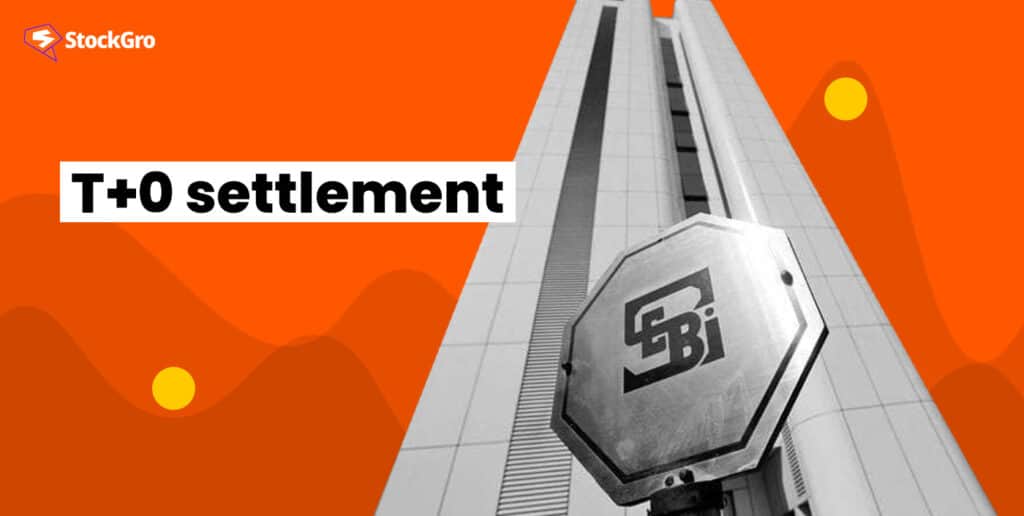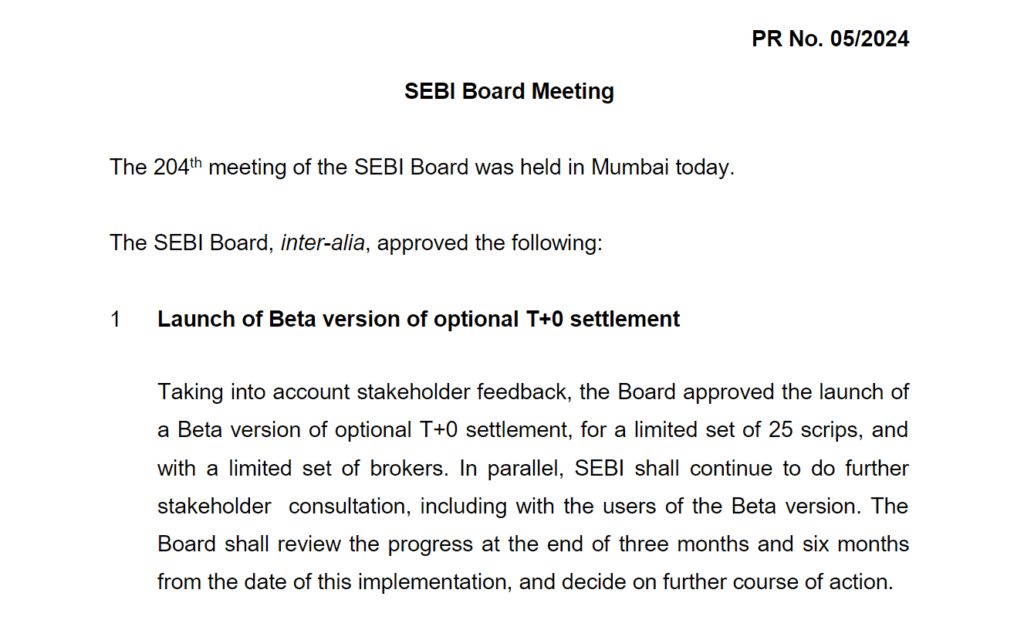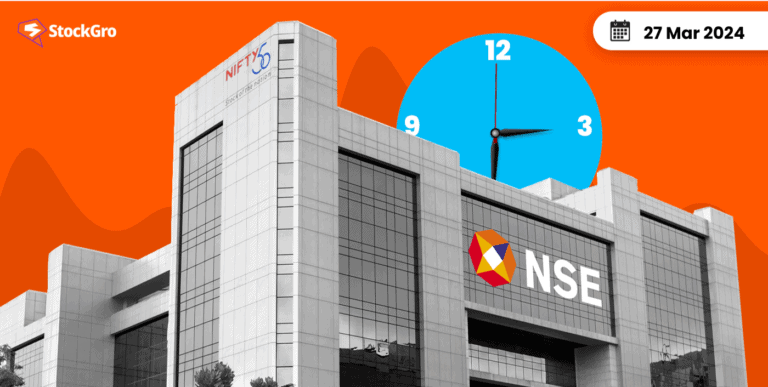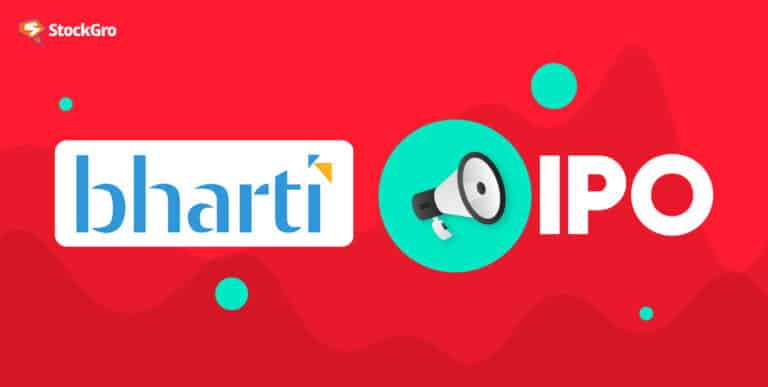
The Indian stock market is on the cusp of a significant transformation as the Securities and Exchange Board of India (SEBI) introduces the T+0 settlement cycle. In a move aimed at boosting efficiency and liquidity, SEBI will launch a beta version of this optional settlement cycle on March 28, 2024.
SEBI’s decision to test T+0 settlement cycle reflects its goal to modernise India’s securities market infrastructure and potentially benefit investors by allowing them faster access to their trade proceeds.
To know more about this groundbreaking move, read this article!
T+0 Settlement – What is it?
Today, Indian stock markets follow a T+1 settlement cycle, meaning funds and securities for a transaction are exchanged on the next business day (T+1). The phased introduction of this system began in 2021 and reached its full operational status by January 2023.
Now, get ready for another shift! A brand new T+0 settlement option is being introduced in beta form. With T+0, trades will be settled on the same day they are placed, streamlining the process and potentially boosting efficiency.
Also read: PM Narendra Modi launches historic infrastructure projects worth ₹1 lakh crore
What’s the news?
India’s stock market regulator, SEBI, is introducing a pilot program for same-day trade settlement (T+0) from March 28. Now, buyers will receive securities, and sellers will receive funds on the same day a trade is executed, unlike the current one-day delay (T+1).

Key points:
- The T+0 settlement will be available alongside the existing T+1 system, allowing investors to choose based on their needs.
- To begin with, the initiative will encompass a curated selection of 25 stocks and will be limited to a specified group of brokers.
- SEBI will closely monitor the program for three and six months, gathering feedback from participants.
- T+0 trades will not be factored into stock market index calculations.
While T+0 is less common than T+1 or T+2 settlements, some exchanges already offer it for specific securities:
- Russia & South Korea: Korea Exchange (KRX) and Moscow Exchange (MOEX) have T+0 for specified stocks.
- Hong Kong: HKEX, or the Hong Kong Stock Exchange, uses T+0 for specific bond and fixed-income transactions.
- Taiwan: The Taiwan Stock Exchange (TWSE) has implemented government securities transaction settlement at T+0 and for selected ETFs.
- US: Same-day settlement exists for some US government securities and money market instruments, but for most equities, it is typically T+2.
This pilot program signifies a potential shift towards faster settlements in the Indian stock market. SEBI’s evaluation will determine the program’s effectiveness and influence future decisions.
Must read: Tata Group stocks surge ahead of anticipated Tata Sons IPO
History
Until now, the Indian securities markets have been functioning on a T+1 settlement cycle. However, in the past, it took longer for trades to settle. The market regulator reduced the settlement time from T+5 to T+3 in 2002, and then to T+2 in 2003. Finally, in 2021, the T+1 cycle was introduced in phases and reached its full operational status by January 2023.
Now, investors will have the choice to settle trades immediately on the same day as the trade. This is called the T+0 settlement cycle. It will be an optional feature alongside the existing T+1 cycle.
The shorter settlement cycles might decrease counterparty risk and boost market liquidity.
Framework for T+0 settlement
Participation in the T+0 settlement cycle is open to all investors who can meet the criteria set by Market Infrastructure Institutions (MIIs) regarding processes, timelines, and risk management. These details will be available on MII websites.
Trading mechanics:
- Trading session: T+0 trading will take place in a unified session between 9:15 AM and 1:30 PM IST.
- Price limits: The price range for T+0 will be confined to a +/- 1% fluctuation (equivalent to 100 basis points) relative to the standard T+1 market price. This range will be recalibrated following every 0.5% change (50 basis points) in the T+1 market.
- Index exclusion: T+0 trades will not be included in market index calculations or settlement price computation. T+0 trades will not have a distinct closing price.
- Settlement independence: There will be no “netting” between T+0 and T+1 settlement obligations. This ensures transactions from each cycle are settled independently.
- Trading holiday: During the settlement holiday, there will be no trading available for T+0 scrips.
MIIs will release operational guidelines, frequently asked questions (FAQs), and a list of qualified stocks on their official websites. Additionally, they will regularly disseminate information regarding broker engagement and the status of settlements.
Also read: From Startup to Giant: UpGrad’s in-depth growth analysis
How will T+0 Cycle benefit investors?
- Accelerated settlement processes result in swifter disbursements and a shortened interval from the execution of trades to their settlement. This frees up capital for investors and enhances overall market efficiency.
- Shorter settlement cycles strengthen risk management for clearing corporations (CCs) by reducing the window for potential defaults or delays.
- Investors gain greater control over their funds with instant receipts and quicker payouts.
- Increased transparency in settlement charges is also expected.
- The T+0 pilot program, alongside measures for Alternative Investment Funds (AIFs), Initial Public Offerings (IPOs), and Foreign Portfolio Investors (FPIs), aims to introduce more flexibility for various market participants.
Bottomline
SEBI’s introduction of a T+0 settlement pilot program marks a significant step towards modernising India’s stock market infrastructure. This optional program, running alongside the existing T+1 system, offers investors the potential benefits of faster access to funds and improved market efficiency.
While the initial rollout is limited, SEBI’s evaluation of the program will determine its wider adoption and influence the future landscape of Indian stock market settlements.

